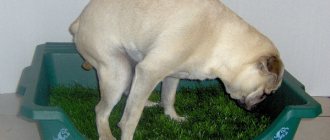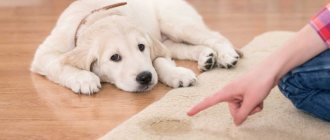Before adopting a dog, you need to understand that it is very important to teach it certain commands. This is necessary so that the owner can control the pet’s behavior. A well-mannered dog should walk next to its owner. This can be achieved in a few days of training. How quickly the training process goes depends on both the dog’s temperament and the owner. In our article we will talk about what techniques can be used to achieve the long-awaited effect.
How to accustom a puppy to a leash and collar
Getting your dog to wear a collar and walk on a leash will require patience and constant training. It's the most important. Not a single pet will happily walk on a leash in a couple of days. To train him correctly, a calm environment and constant practice are necessary.
Promotion
Be sure to prepare tidbits for your puppy. The reward system allows him to determine what exactly the owner praises for. Therefore, express your satisfaction with his behavior not only with intonation, but also with various “goodies” prepared in advance.
You can reward your puppy with more than just food or voice. Moving, active games after training will teach the puppy to value his obedience. He will try to do everything as best as possible so that they will play with him in the finals.
Start of training
It is best if the first acquaintance with the leash occurs not on a walk, but at home, in the most familiar environment. Please be patient and understanding, because it will take some time until your puppy learns to accept the leash adequately. And first he will play with it, gnawing, pulling, trying his strength or trying to escape. At such moments, incentives should not be applied to him. Perhaps the weight of the leash bothers the puppy, so sometimes it’s worth trying to replace it with something lighter: laces or a knitted ribbon. The entire pedagogical task at this stage comes down to not being tempted by the desire to treat the puppy during his first negative reaction to the leash. In this case, it is better to distract the puppy’s attention: a favorite toy, eating or fussing with the owner are ideal moments to fasten the leash for the first time. Familiar and cute activities will distract attention and, at the level of a reflex, will attach to the leash an association with entertainment, after which walking on a leash will also become habitual over time. However, it is important not to turn the leash into a toy - do not allow it to be chewed or tangled in it.
Under no circumstances should you remove the collar or leash if the puppy is trying to get rid of it. It is better to distract or redirect his attention or wait until the dog forgets about them. Pulling and tugging on the leash or pulling on it is also unacceptable: it is better for the first time at home to follow the puppy wherever he pleases than to try to limit his freedom and reflexively reinforce his dislike for the leash.
Do you want your dog to be obedient? Order a walk with elements of training!
Find out more
submit your application
Choosing a leash and collar
The first collar should be flat and light. The pet must get used to the fact that a foreign object has appeared on its neck. The collar should not be allowed to put too much pressure on the neck or dangle loosely. In the first case, the discomfort associated with this “dog accessory” becomes embedded in the animal’s subconscious. In the second, he will simply remove it with his paw. The leash should also be light and strong so that the puppy cannot chew it.
Power of Habit
When first introduced to a collar, don't be surprised if your puppy...
- Whine;
- Remove the leather strap;
- Trying to hide under the sofa;
- Be nervous and even growl.
In some cases, he may try to bite his owner’s hand so that he will remove this inconvenient “bump” and not pester him anymore.
Don't swear or try to force the collar on. During the first fitting, you can distract the puppy with a game or something interesting. If everything went well, give him a treat. Now you can fasten the leash and then walk around the house with your pet. It is important that the first walk in all the “outfits” takes place in a comfortable, calm atmosphere for the puppy.
Walk around the apartment back and forth several times, attracting attention to yourself. You can pick up a toy or treat. Now it is very important not to pull the puppy along with you, but to try to make him walk next to you. After a successful exercise, give him a treat and praise him.
Rules of conduct for the owner during training
In order for the training process to be productive, the owner must follow certain rules during training sessions with the pet. Dog handlers in this situation give the following recommendations:
- Training should be carried out in a familiar environment for the animal. The puppy must be allowed to sniff an object that is new to him, but playing with it and biting it is strictly prohibited. The first training is best done in an apartment or in a closed courtyard area where the pet lives.
- Training should take place in a calm, relaxed atmosphere. The presence of unauthorized persons is not recommended. To prevent the puppy from being distracted, you should limit the number of household members during the lesson.
- The best time for training is 2 - 3 hours after feeding, so that the treats used during the training process are interesting to the puppy.
- Hyperactive animals often have difficulty responding to even simple training techniques. In this case, dog trainers recommend conducting training sessions after a long walk, when the pet’s energy is not so active.
- The owner should be patient and prepare for the fact that the process of training even a young animal to walk on a leash will take more than one day. Depending on the temperament of the ward, the frequency of classes, and the persistence of the owner, the training process lasts from one week to a month.
- The effectiveness of training largely depends on the consistency of the owner. During training, it is necessary to achieve obedience and correct execution of the command, and not move on to the next stage until the previous one is mastered.
- During a training session, it is strictly forbidden to shout at the puppy, much less punish the animal with a leash. Negative emotions will develop fear, mistrust, and anger in the pet towards both the owner and the equipment, and will complicate further training.
- Training should not be tedious for a young animal. The puppy gets tired after 10 - 15 minutes, so training should be short.
- The choice of equipment is of no small importance for productive training. The collar should not put pressure on the puppy's neck. It is best to use light and soft harnesses and leather accessories.
The equipment should not have any foreign odor that distracts the animal from its activities. At first, you should get a short leash no more than 2 meters. This length allows the pet to get used to the innovation and helps the owner control and correct its behavior. Retractable structures (roulettes) are not suitable for training.
Patience, consistency, affection and a friendly attitude of the owner towards the ward are the key to effectively teaching the puppy the basics of education and the intricacies of dog etiquette in public places.
On a walk
After walking on a leash has been practiced at home, you can go outside. It is best to choose a sports ground, park or wasteland. The main thing is that there are no other dogs, crowds of people, and especially cats around.
Only after making sure that there is no “irritant” nearby, fasten the leash to the collar, and start training walking together and the “near” command. Don't forget to reward your puppy's efforts with treats.
Some dogs get used to this type of walking quickly, others will take longer. Only after the commands have been worked out can you go straight out of the house with a leash.
How to teach walking on a leash and collar
Proper behavior on a leash can be taught to a dog at any age. The easiest way to raise a puppy. Training an adult requires more time, patience, and has its own nuances and tricks.
Puppy
After the puppy learns to ignore the collar, the owner should begin teaching him to walk on a leash. In the first couple of days, experienced dog handlers advise only to fasten the leash to a harness or collar. The puppy needs to be called, stroked on the head, and the equipment discreetly fastened on. After several such repetitions, the animal will calmly relate to this manipulation. When the puppy gets used to the sound of the carabiner being fastened, training can continue.
Experienced dog handlers often resort to training leash tactics. For this purpose, a rope no more than 2 meters long is attached to the collar.
The lesson should be carried out in an open and safe place so that the pet cannot hurt itself or run away. The puppy is given freedom - the training leash drags along the ground. This technique allows the dog to get used to the accessory and allows the owner to control unwanted behavior and limit movement by stepping on the free end of the rope.
Once your puppy gets used to the training device, he will not be afraid of the leash.
Positive dynamics in learning must be reinforced with treats. If the puppy does not understand at first what is required of him, he should return to training from the previous stage. Under no circumstances should you shout at the dog or sharply pull the leash. This behavior will reduce positive motivation and prolong the adaptation time.
If the puppy refuses to walk on a leash, sits down or lies down, you should not force or pull him. It is necessary to caress, encourage, and distract the pet from its equipment with the help of affection and play. By switching his attention to entertainment, a new toy, the puppy will stop perceiving the leash as something alien and scary.
Having overcome the fear of a foreign object, the baby can be taught to walk with it. You can entice your pet with you using treats or a favorite toy. Many puppies understand well that they need to follow their owner if during training they take a bowl of food and carry it in front of the animal. This method is effective if training is carried out before feeding.
If the puppy, on the contrary, tries to run ahead and pulls on the leash, the following tactics should be used. As soon as the animal pulls on the leash, you must stop immediately. You cannot pull the puppy. You need to wait until he approaches, and only in this case continue moving. This should be done every time the pet pulls on the leash.
To prevent a young animal from getting tired, training should not exceed 5 minutes for each month of age. If the dog is 2 months old, then training should not last more than 10 minutes.
Adult dog
There are often situations when there is a need to train an adult animal to a leash (long stay in an enclosure, nursery, etc.). Training techniques in this case are somewhat different from leash training a puppy. Training an adult dog should begin with a long leash of at least 5 - 8 meters.
For classes, you must choose an open area. When the dog gets used to walking on a long, loosely hanging leash and is no longer afraid of it, the length can be shortened.
As a rule, an adult animal is reluctant to follow the owner, lags behind and refuses to walk on a short leash. In this case, dog handlers recommend attracting the pet’s attention with a treat, luring and enticing the animal along with you. The tasty piece should be kept in the dog’s field of vision and make sure that when getting to it, the pet does not run ahead or block the road.
The duration of classes with an adult dog should not exceed 20 - 30 minutes. At the slightest sign of overwork and inattention, the training should be stopped and the dog distracted by playing.
To learn how to train a puppy or adult dog to use a leash, watch this video:
Basic mistakes
Inexperienced owners try to immediately walk their pets on a leash, putting it on while still in the apartment. Even if the dog is used to it at home, the situation outside will be completely different. Let's list the main mistakes:
- You cannot choose crowded streets for training. The flickering of strangers, and therefore odors, will greatly distract the puppy. In addition to discomfort in the neck area, crowds, turmoil, and the noise of passing cars will be added;
- Choosing places for training where dog walkers walk their pets is also a bad idea. The puppy will try to “get to know” someone, start playing, or may simply be afraid of the big dog. Therefore, it is best to consolidate the “material” studied at home, in a quiet place;
- Those who do not like to do double work should immediately accustom the puppy to the “near” command. If he confidently walks on a leash in the apartment, then he should walk next to his owner on the street. It is very important to immediately begin to accustom him to this command. If you bought a representative of a large breed, then in the future you will simply run after the grown dog.
Choose a leash so that it is not too short, but not infinitely long. An extendable leash of the “roulette” type is not suitable for training. And it will hardly be useful for an adult animal.
A well-trained dog should always walk alongside its owner. This is especially true for large breeds. Roulette leashes or strict collars will not replace mandatory training if you decide to have a “serious” dog in your home.
Endurance and integrated approach
In the process of training, teaching the dog self-control is of great importance, and it is important not to disrupt the sequence of these actions:
- You need to sit the puppy down or lay it down next to you, and, holding it by the collar, unfasten the leash, without allowing it to get loose;
- Next, you should say “walk” and let the dog go frolic;
- After some time, the puppy is called with the command “come to me”, luring him with a treat or toy;
- The puppy that runs up is encouraged first with a voice, then with affection or a treat, and only then taken on a leash.
Tired of chasing your dog? Book an active walk!
Find out more
submit your application
This exercise is repeated several times, while the dog not only gets used to fastening the leash, but also develops self-control, and also learns the “come to me” command.
When the puppy trusts the leash, another tendency will emerge - he will become excited the moment you fasten it. Of course, a long-awaited walk is planned! Therefore, over time, you will have to develop endurance in a different way: put the dog on a leash at home, for a short time, while continuing to do the usual things and without going out for a walk. Before leaving the house, the dog will have to be calmed, thereby practicing a neutral attitude towards the leash.
To do this, suppress your dog's excitement by locking him alone for a few minutes and then returning. Ideally, by repeating such “walks” you should cause the dog to lose interest in the leash so that he becomes bored and stops throwing himself at doors and pulling you while walking.
Rewarding your puppy's calm behavior also helps: ignore his activity by rewarding him with a treat for standing, sitting, waiting, or lying quietly. Once you notice that your dog is beginning to understand the connection between his calm behavior and rewards, increase the amount of time it takes him to earn his reward. Over time, your dog will learn to follow you at the same pace, stop and wait patiently while you sit on a bench, chat with a neighbor, or wait in line at the checkout line.
Leash
If the tailed prankster gets used to the collar quite quickly, then a problem may arise with the leash. The mischievous one will play with him or bite him.
The strap not only irritates the animal, but also limits its freedom. He will either strive to run forward, or, on the contrary, refuse to move anywhere. Any means will be used. Some stubbornly resist, spreading their weak paws wide and refusing to budge. They may lie on the ground trying to bite the leash.
If “home” training was previously used, then the puppy will not be embarrassed by the feeling of being “tethered” outside. Very soon, he becomes well aware of the connection between the “harmful rope” and the command to “walk”. Then he will be happy to put his head under the collar and bring the strap in his teeth.
To accustom a puppy to a leash at three months, you need to use the same methods that were described. There is no need to keep your pet on a leash all the time. Let him go free in places where he can run freely. Keep him safe. It is better to choose an open, flat space for walking your dog. Periodically fasten the leash and practice the command nearby.
How to teach
Puppy
Teaching your puppy to walk on a leash will help the animal with socialization. When a dog gets used to the collar, it learns to walk on a leash on the street, acquires the skills of obedience and submission to the owner. Of course, the owner should show patience and perseverance, since even the smartest dog will not be able to get used to the leash in one day and feel “like a fish in water.”
The best tool to motivate your pet to obey is encouragement. This is where any learning process should begin. As a reward, they use not only their favorite treats, but also affectionate strokes, kind words, and games with the owner.
First of all, choose the lightest and most comfortable collar for your pet. Leave the decorations and tricks with bells for later. It is necessary to wear a collar at home so that the baby knows that he needs to wear a collar when going outside.
Now let's talk about how to train your pet dog to walk.
Almost all puppies experience stress when wearing a collar. Some literally go hysterical. Be wise, distract your baby with play. After you put it on, be sure to say something kind, pat your ears affectionately, and give him a treat. Let the collar and its wearing be associated only with positive emotions.
During a walk, some kids don’t even notice that a carabiner is attached to the collar, others again fall into hysterics and whine. If this is the first time, then you should let the dog go for a walk, play with it, perhaps in the company of another four-legged friend, and then call it and, at the same time as fastening the carabiner, give it a treat.
If a puppy wriggles on the street and lies down on the ground, then persistently, without raising your voice, without succumbing to a feeling of nervousness, insist on your point. If the baby is afraid, then caress him, but don’t get carried away so that he doesn’t think that now he can always behave this way. Try to stop bad behavior, even if the dog is small.
Many owners who have no experience in dog breeding are wondering how to teach their dog not to pull on the leash while walking. If the puppy pulls on the leash, then always be consistent in your actions. Stop and distract your baby, and then calmly continue your walk.
Next time you need to pull the dog with a sharp jerk and immediately reduce the length. As soon as the tension is released, the jerking stops. If you always repeat the same actions and don’t let your baby pull on the leash, then very soon he will get used to it and stop doing it.
Strengthen your pet's ability to walk on a leash. It’s good if the owner walks ahead when going outside so that the dog learns obedience. During walks, gradually shorten the leash - this way you will teach the dog to walk next to you.
If your pet has difficulty not pulling on the leash, then it is better to walk with a short leash. Be attentive to your puppy while walking. If he does not listen, react extremely calmly, showing boundless love.
Adult pet
An adult dog is taught to walk on a leash using a strict collar. It contains small spikes, and when the dog pulls on the leash, the spikes give him an unpleasant sensation with a short tug. When the skill has been worked out on a strict collar, it is replaced with a regular one.
During training, you should change the length of the leash. Training should not be boring and contain innovations. You can alternate the environment, change the speed of command execution, practice turning after the owner.
How to leash train an adult dog
What to do if there is a need to take into your home an adult animal that previously did not know not only a leash, but also a collar? You should gradually accustom the dog to the fact that he will have to follow some rules of residence׃
- Do not spoil household items;
- Ask to go outside;
- Walk on a leash.
The dog will have to be taught the latter as quickly as possible. Of course, there is no need to walk him around the apartment. An adult dog must be taken outside immediately on a leash.
Usually, once in good conditions and feeling cared for, the dog quickly gets used to the new conditions and rules of life. The main thing is that she has close contact with her owner.
Dog and leash
The dog needs daily walks. For some places there are certain rules for walking, for example, in shops, public transport, and public places with a pet you can enter on a leash and muzzle. The owner can easily control the actions of the animal depending on the length of the leash. Also, the dog must be kept nearby when crossing the roadway and in crowded places.
A leash for a dog is not only control of actions, but also protection from external factors - roads, cars, other animals. Therefore, it is so important to accustom your little four-legged friend to supervised walking from an early age.
What to do if your dog is afraid of “dog accessories”
If an animal begins to panic when it sees ammunition, it is necessary to understand the reasons for this behavior. Fear can cause the following:
- The dog had been beaten with a belt before;
- The dog was kept in chain custody for a long period;
- Forced, too frequent and prolonged wearing of a constricting muzzle.
What should I do to correct the situation?
Frequent walks
Walk more than twice a day. Practice good walking behavior. Remain calm if the animal tries to break or bite the strap. Strictly forbid him to do this, but do not punish him. If your dog is afraid to walk on a leash, move forward a little. She will understand that you are taking control of the situation, she will calm down, and become obedient.
Gradually pull your pet closer to you so that he learns to walk next to you. Encourage his success with treats and your voice. The length of the leash should not exceed two meters. It is worth remembering that the dog will feel calmer next to its owner.
What to do if the puppy does not want to walk on a leash
If your dog refuses to walk on a leash, remove the leash and try to distract him. Then, after a while, try again. If unsuccessful, distract the animal again with a game or treat.
Running helps the best. Put the equipment on the animal, and then quickly run a short distance. The puppy will think that this is a game and will run next to you with excitement. Reinforce the exercise, not forgetting to praise the shaggy miracle. Encourage your pet, but never indulge his whims. Show patience and perseverance, then success is guaranteed.
Currently reading:
- Games to choose for training a dog
- Rules for choosing a ring for a dog show
- The American Cocker Spaniel is an adroit hunter and loyal friend.
- Seven Signs and Remedies for Getting Rid of Fleas in Dogs
What to do if your dog doesn't like the leash
When teaching a puppy to walk on a leash, inexperienced owners make mistakes. They can be overly strict, and negative emotions are fixed in the dog’s mind, or, on the contrary, they feel sorry for the baby, which is why they do not show perseverance and perseverance. Discomfort due to incorrectly selected equipment can also discourage the puppy from any desire to walk on a leash.
Is your dog being naughty and refusing the leash? Check to see if one of the following is the cause:
- the collar is fastened too tightly, and, as a result, every step the dog takes is accompanied by pain and suffocation;
- the puppy was allowed to play with a leash, and now he perceives it as a toy and refuses to walk in it - buy a new one;
- they couldn’t restrain themselves and spanked the pet with a leash, and after that he refuses to walk on it - the use of force is unacceptable. Now slap the accessory on your knee and watch your pet’s reaction. If the puppy flattens his ears, he is afraid of the leash. A special vest-harness for puppies or a lighter leash will help;
- the puppy’s natural desire to play was completely ignored, he was only forced to walk next to him - do not forget about positive emotions! The dog can't wait to run and frolic. If you are going to combine a walk with the puppy and your own business, then the interests of the dog come first.
If you did everything correctly, but still couldn’t train your dog to use a leash, contact a dog trainer for help! Your future peace of mind and the safety of your pet depends on this.











